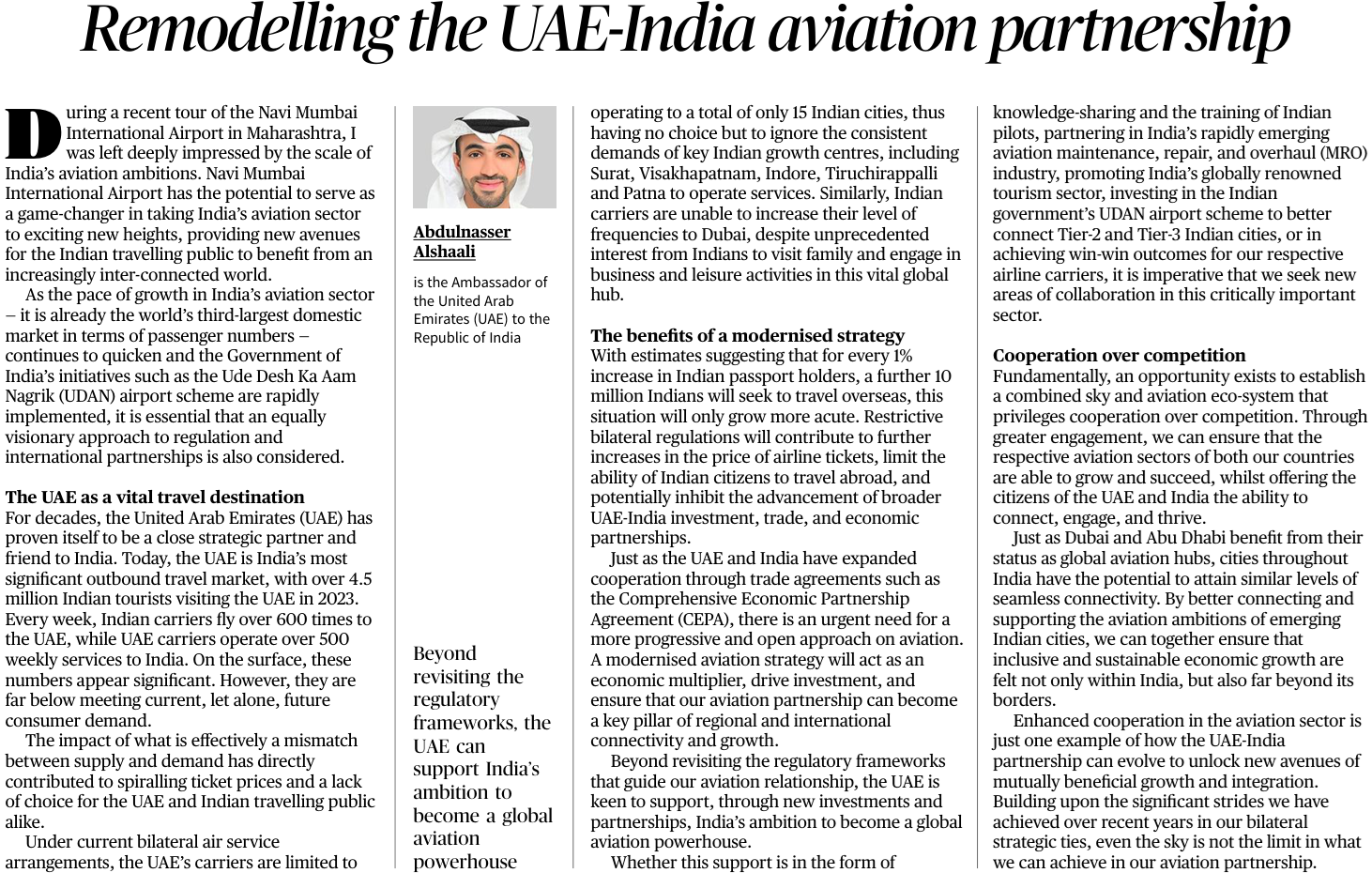1. Revamping UAE-India Aviation Ties for Growth and Cooperation
Introduction
The UAE and India share a robust aviation partnership, with the UAE serving as India’s most significant outbound travel market. However, restrictive regulatory frameworks and a mismatch between supply and demand have hindered the full potential of this relationship. A modernized aviation strategy is crucial for fostering economic growth, trade, and seamless connectivity.
- Importance of UAE for India’s Aviation Sector
- The UAE is India’s largest international travel destination, with over 4.5 million Indian tourists visiting in 2023.
- Indian carriers operate over 600 flights per week to the UAE, while UAE carriers operate 500+ weekly services to India.
- Despite this, the number of flights is insufficient to meet consumer demand, leading to high ticket prices and limited choices.
- Challenges in the Existing Aviation Partnership
- Bilateral restrictions allow UAE carriers to operate in only 15 Indian cities, ignoring growing hubs like Surat, Indore, and Patna.
- Indian carriers cannot increase flight frequencies to Dubai, despite rising demand.
- Restrictive regulations could further increase ticket prices and hinder economic partnerships.
- Need for a Modernized Aviation Strategy
- With every 1% increase in Indian passport holders, an additional 10 million Indians seek to travel abroad, necessitating an open and progressive aviation policy.
- A modernized aviation framework can act as an economic multiplier by driving investment and strengthening India-UAE trade relations.
- Enhanced aviation cooperation aligns with broader trade agreements like the Comprehensive Economic Partnership Agreement (CEPA).
- Areas for Enhanced Cooperation
- Regulatory reforms: Revising outdated bilateral agreements to allow greater airline operations.
- Infrastructure and Training: UAE can support India’s aviation sector through investments in airport development, pilot training, and Maintenance, Repair, and Overhaul (MRO) services.
- Tourism and Connectivity: Strengthening ties to promote India’s tourism sector and improve accessibility to Tier-2 and Tier-3 cities.
- Cooperation Over Competition
- A combined aviation ecosystem that prioritizes collaboration over competition will help both nations thrive.
- Cities across India can achieve global aviation hub status, similar to Dubai and Abu Dhabi.
- Strengthening regional connectivity will boost inclusive and sustainable economic growth.
Conclusion
Enhancing the UAE-India aviation partnership will benefit both nations through economic growth, increased connectivity, and greater investment opportunities. A forward-looking aviation strategy will not only improve travel options but also contribute to the broader vision of making India a global aviation powerhouse.
Bottom of FormMains Practice Question |
Q. Discuss the significance of the UAE-India aviation partnership and the challenges it faces. Suggest measures to enhance cooperation in the aviation sector for mutual economic and strategic benefits. |
2. Establishing India's AI Safety Institute: A Path to Responsible AI Governance
Introduction
India’s Artificial Intelligence (AI) ambitions have taken a significant step forward with the announcement of an AI Safety Institute (AISI) under the Safe and Trusted AI pillar of the IndiaAI Mission. The establishment of AISI aligns with global trends, where countries like the U.K., U.S., Singapore, and Japan have already set up similar institutes to mitigate AI risks. AISI aims to ensure responsible AI development while addressing India-specific challenges.
- Need for an AI Safety Institute in India
- AI models can perpetuate biases, leading to social and economic inequalities.
- Risks related to deepfake technology, misinformation, and cybersecurity threats need structured mitigation.
- AISI can ensure a common technical understanding of AI risks while fostering research and policy development.
- International collaboration is essential for a standardized AI safety framework.
- India-Specific AI Solutions
- India’s diverse linguistic, technological, and socioeconomic landscape presents unique challenges.
- Indigenous AI solutions must focus on:
- AI bias mitigation in the Indian context.
- Addressing the problem of underrepresented data by empowering rural communities.
- Developing multilingual AI for inclusivity.
- Promoting AI governance through ethical frameworks and risk assessment.
- Global Cooperation and AI Governance
- India’s AISI should collaborate with global AI safety networks to address broader risks.
- Adoption of a standardized AI taxonomy would enable interdisciplinary research and common evaluation frameworks.
- Establishment of an international notification framework can help track AI development and prevent misuse.
- Lessons from initiatives like the Bletchley Declaration and Singapore’s AI safety policies can enhance India’s AI governance model.
- Policy Measures for Effective AI Safety Implementation
- AISI should develop AI governance models that balance local relevance with global alignment.
- Interoperability is crucial for ensuring cross-border accountability.
- Collaboration with experts, policymakers, legal professionals, and industry stakeholders is necessary to ensure ethical AI adoption.
- The MeitY-UNESCO partnership on AI readiness provides a strong foundation for regulatory frameworks.
Conclusion
The establishment of India’s AI Safety Institute is a critical step in ensuring responsible AI development and governance. By integrating indigenous AI solutions with international best practices, India can emerge as a global leader in AI safety. The institute must prioritize ethical AI frameworks, collaboration with stakeholders, and adaptive regulations to safeguard technological advancements while promoting innovation.
Mains Practice Question |
Q. Discuss the significance of establishing an AI Safety Institute in India. What challenges does AI governance face in the Indian context, and how can India balance local innovation with global AI safety standards? |



